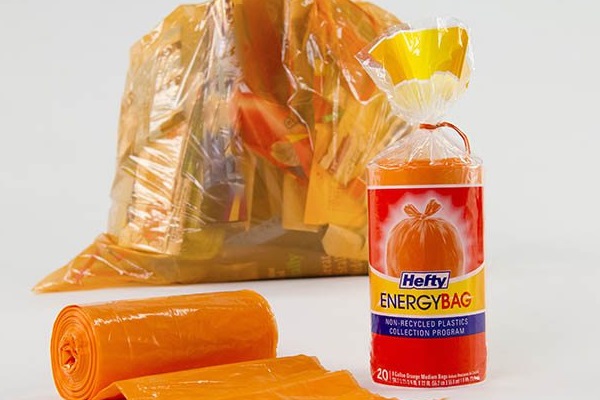
Residents in the Omaha, Neb. area can participate in a program to divert plastics not accepted in the normal curbside stream. | Courtesy of Hefty
Firstar Fiber’s in-house plastic-to-lumber operation is up and running, turning materials collected in orange bags at the curb into plastic composite lumber. The operation also recently survived a fire scare.
Omaha, Neb.-based materials recovery facility (MRF) operator Firstar Fiber is a processing partner in the industry-backed Hefty ReNew program, which collects hard-to-recycle plastics. The project to use the material collected in Omaha as a feedstock for composite lumber was first announced in 2021. Hefty recently rebranded the program – it was formerly known as EnergyBag.
Firstar receives recyclables through Omaha’s curbside recycling program, and from other sources. Omaha participates in the Hefty ReNew program, through which residents can bag hard-to-recycle plastics, and those bags are delivered to Firstar’s MRF, where they’re hand-pulled off the sorting line.
A cement kiln in Kansas City, Mo. was Firstar’s original downstream, but Firstar and project partners envisioned a system where they could manufacture lumber using the material, thereby creating their own market.
Lumber production began in late February. Dale Gubbels, CEO of Firstar, told Plastics Recycling Update that the company is “cranking out boards pretty much every day now.”
Firstar did suffer a three-alarm fire the evening of March 29, but Gubbels said there were no injuries and minimal damage to the building and equipment.
Eyeing 1,000 tons annually
At the Firstar MRF, incoming ReNew bags start on a bag breaker and receive a manual inspection and sort before the contents are sent to a shredder and granulator. The material is then flaked and extruded into the final composite lumber product.
Gubbels said Firstar is currently only running one shift for the lumber, but once it ramps up to full production, the line should be able to process about 1,000 tons per year.
He noted that while that doesn’t sound like much capacity compared to what a typical facility handles, each ReNew bag only weighs about 2 pounds, so “it’s a lot of material.”
At full capacity, the lumber production will use the majority of the ReNew material Firstar takes in, though Gubbels said the company can also pelletize the material so it could be shipped to other facilities if there was demand and excess material.
“We’re exploring a lot of different potential uses for these pellets,” he said.
He estimated that most of the lumber produced will be used locally, because there are several construction companies in the area that have expressed interest.
“It has been very well received,” Gubbels said. “We’re really grateful for this.”
Looking to connect with schools
Looking forward, Gubbels said he’s been reaching out to national brands to try to fund a project he calls “Operation School Board.”
The aim of the project is to give high schools shop classes and community technical colleges access to the composite lumber for community-based projects.
Gubbels said when he learned that due to budget constraints, many students are asked to self-fund material for their shop projects, he saw a great opportunity to grow awareness of composite lumber.
“We were floored to find the majority of schools expect the students to buy their own material for whatever they’re working on,” he said. “That got us thinking – that’s terrible. So that’s how we came up with Project School Board.”
Working with the Nebraska Department of Education, several surveys went out to schools to gather data. Based on the support and interest in the responses, Gubbels reached out to the Nebraska Community Foundation, a nonprofit group that helps communities raise money for local projects.
A survey of involved communities turned up a laundry list of projects they’d like to use composite lumber for, from wheelchair ramps and town stages to gazebos and pedestrian bridges. Benches are also a longstanding favorite, Gubbels noted.
“What we’re proposing in Project School Board is if we can hook the two together, it really creates a circular economy for the types of plastic that otherwise would not be recycled and we can have students learn that these things are resources and build some community projects,” Gubbels said.
More stories about challenging materials
- PET Recycling Coalition doubles down on thermoforms
- RIT researchers develop AI-based textile recycling system
- Nova commissioning first US film recycling plant


